We are very excited to announce our guest preacher for Holy Week and Easter—the Rev. Kristina Andréasson from St. John’s Wood Parish in Central London.
Music in Lent
Offertory Tokens
All things come of thee, and of thine own have we given thee. (1 Chronicles 29:14)
The passing of the offering plate makes tangible and communal the act of supporting God’s work. However, as more of us shift to online giving, there are fewer parishioners participating in this tradition. This week, we are introducing Offertory Tokens to bring back a physical gesture to reinforce this spiritual practice.
If you are one of the many generous parishioners who give online, please collect a Token from the ushers when entering the sanctuary. At the time of the offering, place the Token into the plate as a tangible sign of your support of the work God is doing at St. John’s.
(These tokens will be reused every week—please don’t take them home!)
Returning to the Common Cup in Advent
Dear friends,
As we enter the season of Advent we begin a new Church year which always brings changes to our liturgy and worship patterns (see my e-newsletter this week). One “not-quite-so-Advent” yet still necessary liturgical change on the horizon for us regards our practice of the common cup. As we discussed back in the summer, St. John’s is one of the few parishes in the Episcopal Diocese of Massachusetts which still uses intinction cups during the Eucharist. These were instituted during the pandemic as an additional health precaution which was appropriate for that time. However, as we are no longer in that time, almost all parishes have returned to the traditional practice of receiving communion by sharing a common cup.
We attempted this return to regular practice in the summer. However, amidst many other changes at that time—including some British bloke turning up at one point—we decided to shelve that change for a more appropriate season. During our recent visitation from Bishop Julia, she recommended to our Vergers and Worship Committee that we return to the common cup in the new liturgical year. Bishop Julia prefers a common cup theology, as indeed do I—among numerous others both in the wider Church and among our own parish—and especially given our new Bishop’s suggestion, I am naturally inclined to follow her lead.
Of course, intinction is included in this. The common cup is not about excluding intinction. Rather, it is about enabling everyone, however we receive communion, to share one cup. Both theologically and practically, the common cup is central to Episcopal, indeed Christian identity. For, as we physically receive the bread and wine from the same vessels, we also liturgically and spiritually participate in that same pattern of shared grace and prayerfulness which Jesus shared with his disciples and has been practiced throughout the ages. Furthermore, there are other practical reasons for returning to a shared cup. In the coming months, we will continue to experience a clergy shortage, and, given our children and youth members’ wider commitments we will also encounter a shortage of acolytes and servers at various points. Our altar space is also becoming increasingly cluttered with multiple vessels with fewer people to administer them.
Indeed, if you have questions about health concerns, please do look at the links below to a few widely available sources which hopefully provide some clarity here. They detail not only previous Diocesan recommendations and guidance, but also provide reference to research and policy throughout the Episcopal Church and the Anglican Communion which explain how the common cup has been proven to be a safe practice again for some time.
We will return to our former practice of the common cup this Sunday, The First Sunday of Advent. When you come for communion, you may receive the bread by opening your hands before you. When the cup comes to you, please either guide the chalice to your lips, or you may intinct the bread in the chalice. And again, intinction is allowed, as always. Also, if you wish to receive communion in one kind only (i.e. receiving only the bread or only the wine) then this is full communion as well. If you have questions, then please do not hesitate to reach out to me or one of our Vergers.
With every blessing,
The Rev. Edward Thornley, Rector
and
Tom Daley, Verger
Some helpful links
From The Episcopal Diocese of Massachusetts:
Bishop’s Expanded Remarks on Holy Communion Protocols
From The Diocese of Europe:
Note about receiving Holy Communion by Intinction
From The Rev. Dr. Joshua Daniel, Senior Associate Rector, St. Columba’s Episcopal Church, Washington D.C.:
An early research paper on the common cup during the pandemic:




